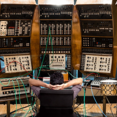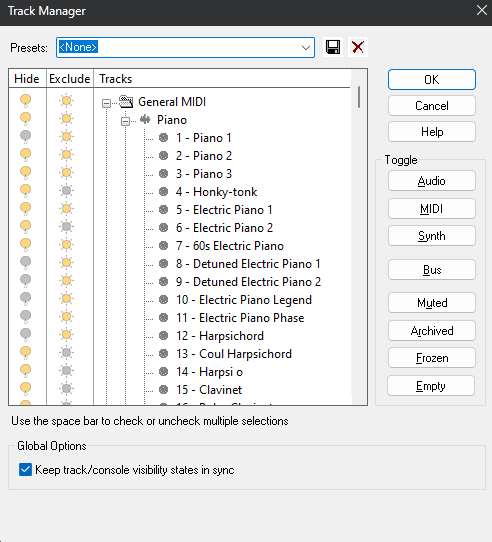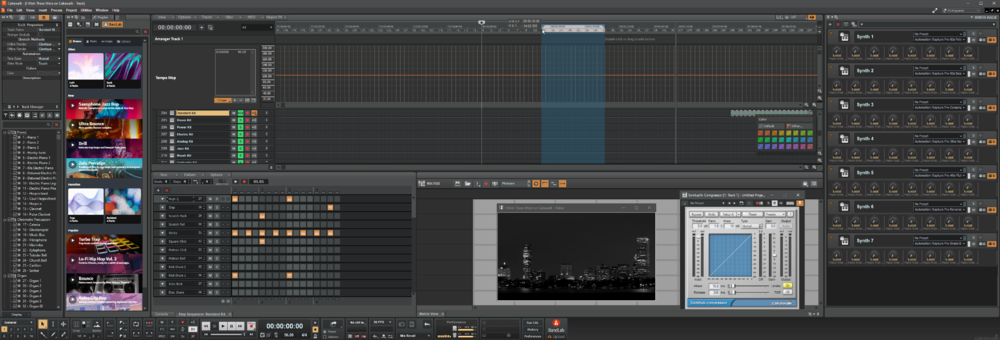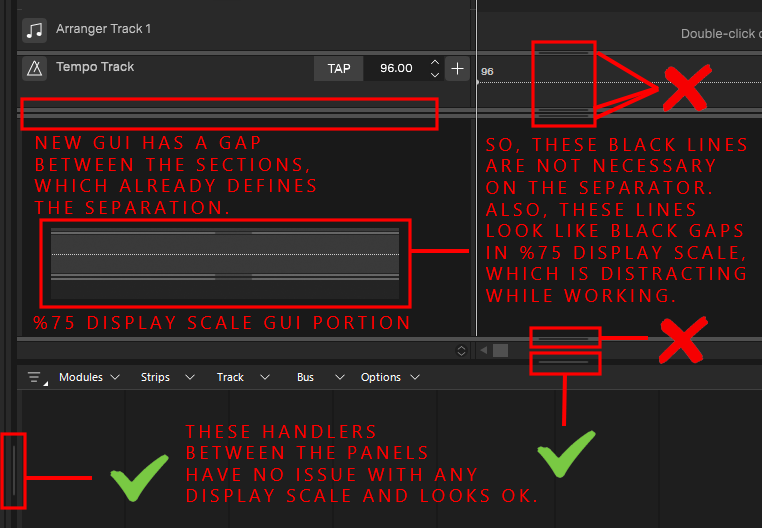-
Posts
654 -
Joined
-
Last visited
Everything posted by murat k.
-
By the way, I really like not only the request itself but also the way it was presented. It directly expresses the topic.
-
Not constantly. Only with those who are off-topic, or those who claim it's hardly off-topic. My general advice: please, if you're not going to contribute to the topic, choose to remain silent.
-
Yes, you're right. Not everyone knows that Session Drummer can be used as a Drag-and-Drop sampler, but everyone who uses it does. However, Session Drummer isn’t relevant to the topic here, especially in a discussion about using Samples directly in the Step Sequencer, not Samplers. Giving off-topic advice hurts the discussion of the main subject. Therefore, it would be more helpful if we try to focus on things that support the original poster's request as much as possible.
-
Everyone knows that this can be done with the help of a Sampler Synth; here, the aim is to use a Sample directly with a Step Sequencer. This can be achieved by selecting a Sample via Drag-and-Drop from the Browser or using the File Explorer in the Step Sequencer menu. Additionally, any existing Sample in the Project can be used in the same way through Drag-and-Drop. Depending on how these files are added, they can either be read from their Original Locations or integrated into the Project Folder as soon as they are added.
-

Exclude Tracks/Buses/Folders from View (Second Level Hiding)
murat k. replied to murat k.'s topic in Feedback Loop
Briefly, this feature ensures that the tracks you exclude remain hidden when using the 'Unhide All' command. Otherwise, you'll need to restore the view using the view preset each time and continuously update your view preset whenever there’s a change. When added, it will look like this in the Track Manager. -
@msmcleodAs I examined it a bit more, I realized that the confusion here actually stems from the difference between the command in the right-click menu and the command we use in the shortcut. The command in the right-click menu is effective for a single automation, while the shortcut provides a global snapshot option for all tracks with the write-enabled parameter active. For the shortcut, a modification could be made so that if it’s not write-enabled, it only takes a snapshot for the focused automation. This way, we wouldn't need to enable write every time we use the shortcut. I would also like to remind you that the newly added 'Left Click Sets Track Focus' global option in Cakewalk Sonar should also work for Automation and Take Lanes. Since we're talking about an issue with an automation-related command, and I've caught you here, I hope you can address this feature as well. :)
-

Exclude Tracks/Buses/Folders from View (Second Level Hiding)
murat k. replied to murat k.'s topic in Feedback Loop
Nice! When this feature is implemented, it will provide you with an additional layer of view preference, serving you much better in your workflow. While thinking about this topic, another specific example came to my mind. For instance, you've created an arpeggio consisting of single long notes. You want to use these arpeggio notes as they are played, but since you might want to make changes later, you decided to duplicate the original track with the long notes to keep it safe. You may never need the duplicate, but who knows? By excluding this track, you can keep it within the file, and even when using the 'Unhide All Tracks' command, it will remain invisible. Use cases can be varied. However, I hope everyone has understood that this feature and its benefits address an important shortcoming in the track view experience and simplify view-related tasks rather than complicating the situation. -

Exclude Tracks/Buses/Folders from View (Second Level Hiding)
murat k. replied to murat k.'s topic in Feedback Loop
So you end up having to update the View Preset for tracks you don’t use constantly or don’t need to see. With this feature, we won’t need to deal with these kinds of things anymore. What you need to do is use the Exclude command when you no longer need a track, that’s it. So your workspace automatically will become WIP as it supposed to be, allowing you to use the view commands without having to see unused tracks anymore. -

Exclude Tracks/Buses/Folders from View (Second Level Hiding)
murat k. replied to murat k.'s topic in Feedback Loop
It's not practical to load a View Preset every time for tracks that we don't need to see or no longer need throughout a project—especially given that we currently access the Track Manager through a separate window from the main one. Once this feature is added, we will use the Track Manager only occasionally, not constantly, to show or hide specific tracks we've excluded or hidden or to load customized View Presets. -
As it is now, we can already create an Automation Snapshot through the right-click menu without Write Enabled. It seems that an unnecessary rule was applied to the shortcut function in the past, and no one has changed it since.
-
I hadn’t detailed the topic, thinking that the developers would find the most suitable method. However, to clarify a few things, this issue can be solved as follows. The Ctrl modifier is quite suitable for temporary node snapping. Currently, there are already situations where it partially functions as a snap feature. It's important to remember that the snapped nodes need to merge into a single node. This way, when we drag a node, another node won't unexpectedly appear underneath it. However, I believe we also need a global on/off toggle to enable or disable node snapping. This would be bind to the global snap function but could be an option that can be toggled, allowing us to continue working with a single shortcut for snapping, just like we do now.
-
Currently, Cakewalk only offers a single-level track hiding option, which is not always sufficient. A second-level hiding feature would allow certain tracks to remain hidden even when using the "Unhide All Tracks" command. When needed, we can reveal these tracks all at once with the "Un-exclude All Tracks" command or manage visibility more selectively through the "Track Manager." Use Case 1: Imagine working on a project with 100 tracks, but focusing on only 10. We’ve hidden the other 90 tracks. Then, we narrow our focus to just 3 tracks and use the "Hide Tracks Not in Selection" command to hide the rest. However, if we apply "Unhide All Tracks," all 100 tracks become visible again. By using the "Exclude Selected Tracks" command to exclude the 90 tracks, the "Unhide All Tracks" command will display only the 10 tracks we’re interested in. Use Case 2: For instance, we can exclude the Metronome Bus from view. Even when we apply the "Unhide All Tracks" command, this bus will remain hidden. To make it visible again, we can untick it in the "Exclude" column in the Track Manager. Additionally, the "Hide Track" command should be expanded to include buses, similar to the request mentioned for the "Delete Tracks" command in this thread. Note: "Undo view" command is not a solution, and this thread is closed to any workarounds or differing opinions.
-
The significant functional gap is ensuring that two nodes become a single node when we bring them closer together. When we delete a node, there are two possibilities: it will either connect to the other node or it won’t. Sometimes it connects, and sometimes it doesn’t. So, there is no solution in place. When a node is brought close to another node and it’s not intended to snap, snapping function can temporarily be disabled or enabled with a modifier, which is something we've been doing for other things as well, so there’s nothing awkward about it. P.S. I have no intention of competing with anyone; my goal is to contribute to the development of Cakewalk. Your attitude here seems intent on maintaining the status quo, which clearly hinders progress.
-
Thank you for the information. Could you disable the write enable feature for the shortcut to work? There is no need for that.
-
Another ongoing issue for years. This is the thread that makes me most doubt the usefulness of the requests we make here.
-
I am bringing this issue back to the agenda again because there has been no progress since this thread. Sadly, I hear or see that many film composers have abandoned Cakewalk and switched to other software. The lack of development in video support is just one aspect of this. Perhaps improvements in this area won't bring back the musicians who left, but it might prevent new users from leaving.
-
Please stop accepting workarounds as solutions and support someone when they come up with a real solution, or stay silent. Otherwise, you're not helping either the development of Cakewalk or those trying to support its progress.
-
I've been waiting for a long time for Track Manager to appear in the Track Properties tab in the Inspector, just like in this image.
-

Accessing QUADCURVE EQUALIZER Panel from the Tiny EQ
murat k. replied to murat k.'s topic in Feedback Loop
Reminder. -
With the new GUI update in Cakewalk Sonar, thin black lines have been added in the middle of panel separators. In the previous GUI, there were no gaps between the panels, but in the new interface, the separations are already defined by these gaps. Therefore, I believe the black lines on the separators are unnecessary, especially at 75% display scale, where they appear like black gaps, which can be distracting while working. On the other hand, the handler lines between different sections are not visually disturbing and do not cause any issues at any display scale. Requesting the removal of the black lines on the panel separators or, alternatively, the option to hide them.
- 1 reply
-
- 1
-

-

Plugin Name Display Issue for MFX Plugins in Cakewalk Sonar
murat k. posted a topic in Feedback Loop
MFX Plugins used to appear with their default Display Name when added to the relevant track. However, with Cakewalk Sonar, it seems that this has been replaced by the 'Friendly Name' of the related MFX plugin. The problem here is that 'Friendly Name' often includes the company information, making the required information cutout due to the narrow plugin name field. What should happen is that, just like with Audio FX Plugins, the plugin should appear in the Plugin Menu Layout with the name it has been given. So, the MIDI FX Plugins should be added with the name that appears in the active Plugin Menu Layout, just like Audio FX plugins. -
I request that the Replace Synth Plugin menu appear when clicking on a related track with Alt+Right Click in Track View. This would make replacing synths more practical. When frequently searching for the right sound, having a single menu instead of two different context menus would eliminate unnecessary effort and streamline the process.
-
I am requesting that the scope of the 'Delete Track' shortcut in the Console View and Track View be expanded to include selected Folders and Buses. In other words, if folders or buses are part of the selection, they should also be deleted with the same command. This way, we won't have to use Right Click to delete folders or buses, and we can complete the task with a single shortcut.









